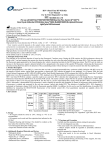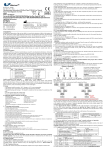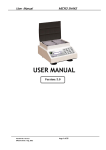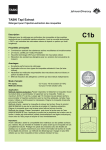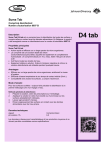Download DATA SHEET HIV-2 Real Time RT-PCR Kit
Transcript
DATA SHEET HIV-2 Real Time RT-PCR Kit Cat. No: SR-0021-02 For use with ABI Prism®7000/7300/7500/7900; Smart CyclerII;iCycler iQ™4/iQ™5; Rotor-Gene6000;Mx3000P/3005P; MJ-Option2/Chromo4; LightCycler®480real time PCR systems For In Vitro Diagnostic Use Only User Manual 1. Intended Use HIV-2 real time RT-PCR kit is used for the detection of HIV-2 in serum by using real time PCR systems. 2. Principle of Real-Time PCR The principle of the real-time detection is based on the fluorogenic 5’nuclease assay. During the PCR reaction, the DNA polymerase cleaves the probe at the 5’ end and separates the reporter dye from the quencher dye only when the probe hybridizes to the target DNA. This cleavage results in the fluorescent signal generated by the cleaved reporter dye, which is monitored real-time by the PCR detection system. The PCR cycle at which an increase in the fluorescence signal is detected initially (Ct) is proportional to the amount of the specific PCR product. Monitoring the fluorescence intensities during Real Time allows the detection of the accumulating product without having to reopen the reaction tube after the amplificaton. 3. Product Description Human immunodeficiency virus (HIV) is a retrovirus that can lead to acquired immunodeficiency syndrome (AIDS). Infection with HIV occurs by the transfer of blood, semen, vaginal fluid, pre-ejaculate, or breast milk. HIV infection in humans is now pandemic. Two species of HIV infect humans: HIV-1 and HIV-2. HIV-1 is more virulent. It is easily transmitted and is the cause of the majority of HIV infections globally. HIV-2 is less transmittable and is largely confined to West Africa. HIV-2 real time RT-PCR kit contains a specific ready-to-use system for HIV-2 detection through Reverse Transcription Polymerase Chain Reaction (RT-PCR) in the real-time PCR system. The master contains Super Mix for the specific amplification of HIV-2 RNA including subtype A~G. The reaction is done in one step real time RT-PCR. The first step is a reverse transcription (RT), during which the HIV-2 RNA is transcribed into cDNA. Then, a thermostable DNA polymerase is used to amplify the specific gene fragments by polymerase chain reaction (PCR). Fluorescence is emitted and measured by the real time systems´ optical unit during the PCR. The detection of amplified HIV-2 DNA fragment is performed in fluorimeter channel FAM with the fluorescent quencher BHQ1. In addition, the kit can be used for identification of possible PCR inhibition by measuring the HEX/VIC/JOE fluorescence of the internal control (IC). An external positive control defined as 7 1×10 IU/ml is supplied. It allows the determination of the gene load. For further information, please refer to section 9.3 Quantitation. 4. Kit Contents Analysis sensitivity: 5~103IU/ml; LOQ: 1~104`1~108IU/ml 5. Storage • All reagents should be stored at -20°C. Storage at +4°C is not recommended. • All reagents can be used until the expiration date indicated on the kit label. • Repeated thawing and freezing (>3x) should be avoided, as this may reduce the sensitivity of the assay. • Cool all reagents during the working steps. • Super Mix should be stored in the dark. 6. Additionally Required Materials and Devices • Biological cabinet • Real time PCR system • Desktop microcentrifuge for “eppendorf” type tubes (RCF max. 16,000 x g) • Vortex mixer • RNA extraction kit • Real time PCR reaction tubes/plates • Cryo-container • Pipets (0.5μl – 1000μl) • Sterile filter tips for micro pipets • Sterile microtubes • Disposable gloves, powderless • Biohazard waste container • Refrigerator and Freezer • Tube racks Gentaur Molecular Products Voortstraat 49 1910 Kampenhout, Belgium 7. Warnings and Precaution Carefully read this instruction before starting the procedure. • For in vitro diagnostic use only. • This assay needs to be carried out by skilled personnel. • Clinical samples should be regarded as potentially infectious materials and should be prepared in a laminar flow hood. • This assay needs to be run according to Good Laboratory Practice. • Do not use the kit after its expiration date. • Avoid repeated thawing and freezing of the reagents, this may reduce the sensitivity of the test. • Once the reagents have been thawed, vortex and centrifuge briefly the tubes before use. • Prepare quickly the Reaction mix on ice or in the cooling block. • Set up two separate working areas: 1) isolation of the RNA/ DNA and 2) amplification/detection of amplification products. • Pipets, vials and other working materials should not circulate among working units. • Use always sterile pipette tips with filters. • Wear separate coats and gloves in each area. • Avoid aerosols 8. Sample Collection, Storage and transport • Collected samples in sterile tubes; • Specimens can be extracted immediately or frozen at -20°C to -80°C. • Transportation of clinical specimens must comply with local regulations for the transport of etiologic agents. 9. Procedure 9.1 RNA-Extraction Different brand RNA Extraction kits are available. You may use your own extraction systems or the commercial kit based on the yield. For the RNA extraction, please comply with the manufacturer’s instructions. The recommended extraction kit is as follows: molecular grade water before detection, and close the tube immediately then vortex for 10 seconds. Because of transportation with carbon dioxide ice, there may be white precipitate in tubes of internal control and positive control, but it will disappear in a few minutes when it is incubated at room temperature. Besides, the white precipitate have no effection on the detection result. 9.3 Quantitation The kit can be used for quantitative or qualitative real-time RT-PCR. A positive control defined 7 as 1×10 IU/ml is supplied in the kit. For performance of quantitative real-time PCR, standard dilutions must be prepared first as follows. Molecular Grade Water is used for dilution. The step of dilution is not needed for performance of qualitative real-time PCR. 7 Take positive control (1×10 IU/ml) as the starting high standard in the first tube. Respectively pipette 36ul of Molecular Grade Water into next three tubes. Do three dilutions as the following figures: To generate a standard curve on the real-time system, all four dilution standards should be used and defined as standard with specification of the corresponding concentrations. Attention: A. Mix thoroughly before next transfer. 7 B. The positive control (1×10 IU/ml) contains high concentration of the target DNA. Therefore, be careful during the dilution in order to avoid contamination. 9.4 RT-PCR Protocol The Master Mix volume for each reaction should be pipetted as follows: 9.2 Internal Control and Positive Control It is necessary to add internal control (IC) in the reaction mix. Internal Control (IC) allows the user to determine and control the possibility of PCR inhibition. Add the internal control (IC) 1μl/rxn and the result will be shown in the HEX/VIC/JOE. Attention: It is necessary to dilute the internal control supplied in the kit by 10 times with Gentaur Molecular Products Voortstraat 49 1910 Kampenhout, Belgium ※PCR system without HEX/VIC/JOE channel may be treated with 1μl Molecular Grade Water instead of 1μl IC. 1) The volumes of Super Mix and Enzyme Mix per reaction multiply with the number of samples, which includes the number of controls, standards, and sample prepared. Molecular Grade Water is used as the negative control. For reasons of unprecise pipetting, always add an extra virtual sample. Mix completely then spin down briefly in a centrifuge. 2) Pipet 20μl Master Mix with micropipets of sterile filter tips to each of the Real time PCR reaction plate/tubes. Separately add 5μl RNA sample, positive and negative controls to different reaction plate/tubes. Immediately close the plate/tubes to avoid contamination. 3) Spin down briefly in order to collect the Master Mix in the bottom of the reaction tubes. 4) Perform the following protocol in the instrument: 45°C for 10 min, 1 cycle;95°C for 15 min, 1 cycle;95°C for 15 sec, 60°C for 60sec, 40 cycles. Fluorescence is measured at 60°C;FAM and HEX/VIC/JOE channels should be chosen. 5) If you use ABI Prism® system, please choose “none” as passive reference and quencher. Control appears. The sample does not contain any HIV-2 RNA. It can be considered negative. 4) Neither in channel FAM nor in channel HEX/VIC/JOE is a signal detected. A diagnostic statement can not be made. Inhibition of the RTPCR reaction. 10. Baseline setting: just above the maximum level of molecular grade water. 11.Calabration for quantitative detection: Input each concentration of standard controls at the end of run, and a standard curve will be automatically formed. 12.Quality control: The Ct value of molecular grade water and positive control in FAM channel shows UNDET and ≤35 respectively; The Ct value of internal control in HEX/VIC/JOE channel shows 25~33; Correlation coefficient of standard curve should be ≤-0.98, otherwise the result is invalid. 13. Data Analysis and Interpretation The following results are possible: 1) The Ct value in channel FAM shows ≤38. The result is positive: The sample contains HIV-2 RNA. 2) The Ct value in channel FAM shows 38~40, please repeat again. If the result still shows 38~40,it can be considered negative. 3) In channel FAM no signal is detected, at the same time, a HEX/VIC/JOE signal from the Internal Gentaur Molecular Products Voortstraat 49 1910 Kampenhout, Belgium




